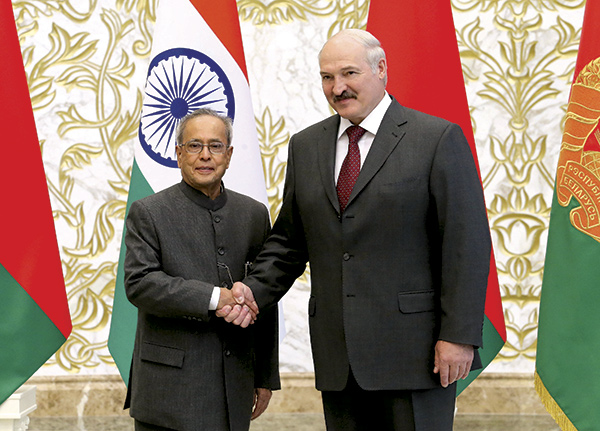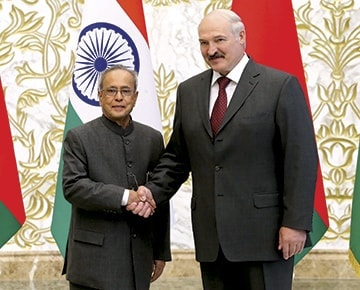
President of Belarus Alexander Lukashenko meets President of India Pranab Mukherjee
The Indian President’s visit to Belarus continues a series of key foreign political events of late, Minsk having been visited by Chinese President Xi Jinping recently, and Alexander Lukashenko having paid an official visit to Pakistan.
Belarus is known for its commitment to a multi-vector foreign policy, with such meetings as those mentioned above acting as a clear illustration. They reflect our process of trade consolidation (which is gaining momentum), liaising with countries confidently becoming new world economic leaders.
Some time ago, the People’s Republic of China proposed the initiative of the new Silk Road trade zone, involving India, Pakistan, the Eurasian Economic Union countries, and a range of other states. The Chinese Foreign Minister explains the idea, noting that the aim is to provide mutual benefit: ‘a symphonic concert of partners rather than a solo attempt’.
Looking at the map, it’s clear that the intention is to create more than an overland connection between eastern China and Europe, since sea routes are included: across the Indian Ocean, and the South China, Red and Mediterranean seas. This global project could never be implemented alone, even by a very large and rich country; it relies on the collaboration of many, in a constructively-disposed world. Belarus has a key role to play, being the only calm and stable corridor between Europe and Asia in our region. It’s little wonder that the largest countries are eager to engage in dialogue with us.
Communication between the presidents of Belarus and India began with recollections of their first meeting in New Delhi, in 2007, when Mr. Lukashenko visited. This was a catalyst for new dynamics of inter-state interaction. At that time, Pranab Mukherjee was Foreign Minister, creating the foundations of our relationship, to mutual benefit. The Indian President recalled that occasion with warmth, noting the friendly relations which connected India and the USSR and adding his hopes that future partnerships will be just as strong, if not even stronger. He is keen to expand interaction with Minsk, echoing the feelings of the President of Belarus. Mr. Lukashenko underlined that our country has no desire to be ‘isolated’ and is proud of its good relationship with such a powerful state as India.
Further talks concentrated more on business and Mr. Lukashenko told his Indian colleague his view on promising areas of co-operation. For example, boasting contemporary technologies and equipment, Belarusian specialists are ready to take part in the modernisation of Indian mining industry. They can also advice how to enhance the efficiency of oil and gas sector.

During the Belarusian-Indian Business Forum
In the nearest time, India plans to considerably enhance its level of coal extraction. Of course, it will need to ensure a reliable fleet of heavy-duty dump trucks; our BelAZ vehicles are already working at its enterprises successfully, making them an obvious choice for further supply. Belarus is already setting up a service centre to maintain its machinery, with its first such centre to open later this year in India.
Collaboration in tractor building is also on the agenda, our ‘Belarus’ tractors being well-known in India since the 1960s and 1970s. They helped achieve the ‘green revolution’, which brought significant rises in crop yields from Indian fields.
The ‘Made in India’ governmental programme aims to attract new production technologies into the country, including joint production ventures — such as for the manufacture of buses, trucks, communal and road-construction machinery. Belarus has much to offer in this sphere.
India is also keen to access the markets of adjoining states, as well as organising commodity distribution networks, banking and joint financial provision for projects.
Belarusian has also proposed educational initiatives to reinforce manufacturing success. Another large-scale Indian programme is the Development of Professional Skills, for which Belarus could help train specialists across various spheres, via technical training centres in India.
Minsk is eager also to welcome Indian specialists to Belarus, liaising in the sphere of power engineering and other infrastructural projects. Undoubtedly, such collaboration is beneficial to both states.
The achievements of the Indian pharmaceutical industry are recognised worldwide and Belarus would welcome investments into its own branch, as well as joint ventures in nano- and biotechnologies, microelectronics, machine building and renewable energy. The Great Stone Industrial Park is oriented in this direction, and would welcome high-tech Indian companies.
President Mukherjee asserts that India is very interested in our proposed areas of interaction, being convinced that today’s level of turnover is far from showing our true potential. Meanwhile, India is opening a credit line worth $100m, for joint projects.
The roadmap of Belarusian-Indian collaboration was a key document of the meeting, guiding areas for development. Meanwhile, the Belarusian-Indian Business Forum tackled how ‘real’ liaisons are to be achieved.
Mr. Lukashenko has offered India unhindered access to the Eurasian Economic Union market, via setting up manufacturing in Belarus, as he noted, speaking at the Belarusian-Indian Business Forum. The Head of State believes that Belarus and India can reinforce interaction in the spheres of industry, power engineering, logistics, communication, bio- and nano-technologies. In addition, Belarus is keen to develop joint production in the spheres of pharmaceuticals, IT and communication technologies.
“We suggest setting up such enterprises at the Great Stone Industrial Park,” noted the President of Belarus, inviting representatives of Indian business circles to tour the Park, and see its potential. “By opening manufactures in Belarus, you’ll be able to enjoy unhindered access to the market of the Eurasian Economic Union and will be able to explore the markets of the European Union,” noted the Belarusian Head of State. “You understand well that there are no better logistical options for working in the two unions, since Belarus is geographically located at the very centre of these economic giants.”
Mr. Lukashenko stressed that Belarus is focused on co-operation across the regions, believing that such interaction fills bilateral trade-economic ties with new content. The President added that direct contacts between Belarus and the Russian Federation are a good example.
President Mukherjee also took part in the business forum, joining Mr. Lukashenko in unveiling a memorial devoted to interaction between Indian and Belarusian specialists in reconstructing the Grodno TPP-2.

Mr. Lukashenko visited New Delhi in 2007, meeting Pranab Mukherjee to discuss measures to be taken to develop ties between our countries. At that time, Minsk and New Delhi intended to triple turnover, bringing it closer to $0.5bn. This goal was achieved in 2012, when the volume of bilateral trade reached $494.6m. Political contacts at top level in 2007 brought genuine business continuation.
Unfortunately, the world crisis took its toll. By 2013, mutual trade had fallen significantly. It revived in 2014 and is now ready for new stimuli, inspiring dynamic interaction between our two countries. The official visit of the Indian President to Belarus should facilitate this.
By Vasily Kharitonov











